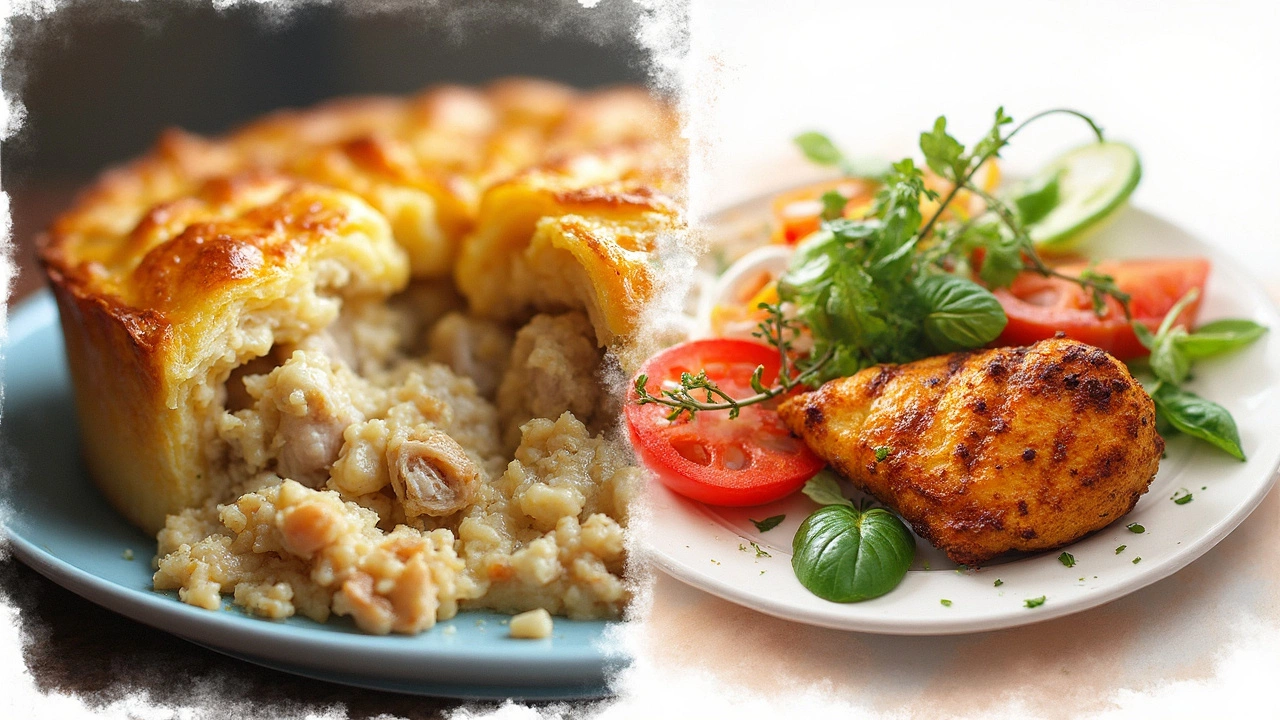We all love a good chicken meal, right? But not all chicken recipes are created equal. Some are downright unhealthy, loaded with fats, calories, and alarming ingredients. It's time we pull back the curtain and see what's lurking in those delicious but dangerous dishes.
First things first, let's talk about what makes a chicken dish unhealthy. It's not just the chicken itself—it's often the way it's cooked and what's added to it. Frying, for instance, loads up the calories and fats. And sauces? They can be sneaky sugar bombs or salt traps without you even realizing it.
Ever heard of chicken dishes like 'General Tso's Chicken'? They taste great but are swimming in sugar and sodium. Knowing how ingredients can turn a meal into a diet disaster is the first step in making smarter food choices. So, are you ready to make your chicken meals healthier without losing flavor? Stick around, and let's chat about how!
- The Hidden Dangers in Chicken Dishes
- Decoding Labels: What to Watch For
- Surprising Ingredients in Unhealthy Chicken Meals
- Tips for Healthier Chicken Cooking
The Hidden Dangers in Chicken Dishes
Chicken dishes often seem like the healthier choice, but some are anything but. One of the biggest culprits is how we cook the chicken. Frying, for example, might make the skin crispy and delicious, but it also douses your meal in unnecessary fats and calories. No wonder fried chicken is a heavyweight in the unhealthy food category.
Let's not forget the sauces. Many popular chicken recipes are drenched in sauces like BBQ or buffalo, which can be loaded with sugar and excessively high sodium content. Just a couple of tablespoons can wreck your daily recommended intake. Instead of savoring a mouthwatering meal, you're risking health issues without realizing it.
Surprising Unsung Villains
Another hidden danger? Trans fats. They're lurking in not only commercially fried chicken dishes but also in some packaged and processed chicken meals. These artificial fats contribute to heart disease, yet they're tricky to spot on labels. Always check for 'partially hydrogenated oils' on ingredient lists.
Beware of the Combo Meals
Combo meals at fast-food joints often entice with a good deal, but they're a triple threat. With fried chicken, fries, and sugary sodas bundled together, your calorie and sugar intake skyrocket. A single meal can often account for more than half the daily calories an average adult requires, masking as a harmless treat.
It helps to approach chicken meals with a mindful eye. Being savvy about what goes into your favorite chicken meals can lead to smarter, healthier choices.
| Nutrient | Recommended Daily Value | Typical Fast-Food Chicken Meal |
|---|---|---|
| Calories | 2000 kcal | 1200 kcal |
| Sodium | 2300 mg | 2500 mg |
| Sugar | 25-37 g | 60 g |
Decoding Labels: What to Watch For
When it comes to identifying unhealthy food, the answer often lies in understanding food labels. These labels, tucked away on packages, reveal a lot about what's really in your beloved chicken recipe.
Understanding Ingredients
First things first, check the ingredients list. It's a goldmine of information. If you see stuff like 'hydrogenated oils' or 'high fructose corn syrup,' it's a signal that you're dealing with an unhealthy dish. Keep an eye out for preservatives too; while they're great for shelf life, they're not so great for your health.
Nutritional Facts That Matter
Next, it's all about the nutritional facts box. Calories aren't everything, but they're a good start. High calories often mean a less-than-ideal meal. Look for the hidden traps like sodium and sugar content. A standard meal shouldn't exceed 600 mg of sodium if you're watching your salt intake.
| Component | Watch For |
|---|---|
| Calories | Often sneakily high in processed meals |
| Sodium | Over 20% of daily value is too much |
| Sugars | Avoid dishes with added sugars |
Serving Sizes and Tricks
Watch out for serving sizes; they're trickier than they look. The total calories listed can be for a single serving, but the package might contain more than one serving—so you're actually consuming more calories than you think if you eat the entire thing.
Also, be wary of terms like 'natural' or 'organic.' They sound healthy, sure, but they don't necessarily mean low-calorie or low-fat. Always peek at the label for the real deal.
Now that you know what to look out for, you'll be better equipped when choosing a chicken meal. It might take some practice, but it's worth it to steer clear of those unfortunate unhealthy meals.

Surprising Ingredients in Unhealthy Chicken Meals
It's crazy how some ingredients sneak into your beloved chicken dishes and turn them into calorie-packed meals. Let's dive into some of the offenders that might just surprise you in these unhealthy chicken recipes.
Added Sugars
Sugar in chicken? Absolutely, and not just a sprinkle. Sweeteners find their way into sauces and marinades, especially in dishes like orange chicken or honey garlic chicken. They play a major role in boosting flavors but come with heavy doses of extra calories.
Sodium Overload
Salt's the usual suspect, enhancing taste, but many chicken meals contain way more sodium than you need. Soy sauce, bouillon cubes, and other blends often make the everyday chicken option a sodium bomb. That’s not doing any favors to your heart health.
Thickening Agents
Think those creamy sauces come from cream alone? Nope. Many rely on thickening agents like cornstarch or flour to achieve that lush texture. It adds carbs and unnecessary calories, pushing your dish into the unhealthy dishes category.
Preservatives and Additives
To keep things fresh or shelf-stable, precooked chicken options are loaded with preservatives. Phosphates and nitrates preserve the look and taste, often at the cost of good nutrition. Always check those labels if you're reaching for convenience.
The Oil Explosion
We all know that frying chicken means oil, but sometimes a little goes a long way. High-fat content oils can double the calorie count, turning a simple cutlet into a heart attack on a plate. Opting for healthier oils or baking can be game-changing.
Here’s a quick glance at how some ingredients stack up:
| Ingredient | Calories Per Tablespoon | Sodium Content (mg) |
|---|---|---|
| Soy Sauce | 9 | 902 |
| Cornstarch | 30 | 0 |
| Honey | 64 | 0 |
So next time you're whipping up or ordering chicken recipes, keep an eye out for these ingredients. A few mindful swaps can make your favorite dishes much healthier without sacrificing taste.
Tips for Healthier Chicken Cooking
Let's face it, making chicken recipes healthier doesn't mean you have to sacrifice taste. With a few tweaks, you can enjoy delicious meals that are kinder on your waistline. Here are some actionable tips to get you started:
1. Opt for Grilling, Roasting, or Baking
Instead of reaching for the fryer, consider grilling, roasting, or baking your chicken. These methods use less oil, helping you cut down on unnecessary fats. Plus, they allow the chicken's natural flavors to shine.
2. Mind the Marinade
Watch out for sugary and salty store-bought marinades. Try making your own using herbs, lemon juice, and a bit of olive oil. This way, you can avoid hidden sugar and sodium, and customize flavors to your liking.
3. Keep Skin Contact to a Minimum
Everyone loves crispy chicken skin, but it’s packed with saturated fats. Either opt for skinless chicken breasts or thighs, or remove the skin after cooking to enjoy the flavor without the added fat.
4. Load Up on Veggies
Pair your chicken with a generous side of vegetables. Whether roasted, steamed, or grilled, veggies add nutrients and bulk to the meal, helping you feel satisfied without carbohydrates like pasta or bread.
| Cooking Method | Calories per 100g | Fat Content |
|---|---|---|
| Grilled Chicken | 165 | 3.6g |
| Fried Chicken | 274 | 14g |
| Roasted Chicken | 187 | 7.8g |
5. Choose Whole Grain Sides
If you’re having chicken with a side, go for whole grains like brown rice or quinoa. They are full of fiber and can keep hunger at bay, unlike white rice or refined grains.
Following these steps will get you far in turning those unhealthy dishes into ones that won't compromise your health or your taste buds. Small changes can make a big difference!

